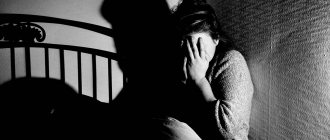Panic is a reaction of the body in response to stress that is threatening in nature. We all sometimes experience this feeling when we find ourselves in dangerous or hopeless situations, as it seems to us. But there is a category of people who experience causeless panic in a state of absolute peace and relaxation. Such anxious episodes represent a specific neurotic disorder called panic disorder.
What is it characterized by?
Panic disorder is recurrent episodes of panic attacks. It affects about 3% of the population, and this is three times the incidence of endogenous disorders such as schizophrenia or manic-depressive disorder. The disease is more common in women than men and develops between the ages of 20 and 60 years.
The frequency of panic attacks ranges from several per day to several per month. It is possible that their frequency is reduced to a couple of attacks per year. Its duration is 5–30 minutes, reaching an average of 10 minutes.
To make a diagnosis of panic disorder, several points must be present:
- absence of a specific, provoking situation. The attack occurs suddenly, in conditions familiar to a person;
- attacks of unreasonable anxiety are repeated several times a month;
- exacerbation is accompanied by vegetative symptoms, disorientation in space and in one’s personality;
- absence of other mental illness;
- lack of effect of a psychotic substance - alcohol, drugs;
- there is a fear of dying or going crazy.
But the main conditions for combining isolated attacks into a disorder are the fearful expectation of a repeat attack and the formation of protective behavior.
The causes of panic disorder have not been fully established. It is assumed that an imbalance of neurotransmitters in the brain may contribute to its appearance. For example, excess amounts of adrenaline, norepinephrine and a lack of serotonin increase the likelihood of developing anxiety and feelings of fear.
On the other hand, hyperexcitability of the amygdala in the brain may contribute to unreasonable panic attacks. Any information entering our brain is assessed as dangerous or safe. If any information has been recorded as threatening, a signal about this is transmitted to the amygdala. In response, it causes excitation of physiological reactions of the body: the release of adrenaline, changes in breathing, as well as behavioral characteristics. The person enters a state of hyperarousal and prepares for defensive behavior.
If the amygdala is overexcited, then such reactions are doubly intensified; they occur chaotically, even when there are no adequate reasons.
Contributing to a panic attack:
- heredity;
- childhood violence;
- bad habits - they deplete the nervous system, which reduces resistance to stress;
- previous stress;
- hormonal changes - pregnancy, childbirth, puberty;
- a sedentary lifestyle – it provokes a concentration of tension, mental and physical. In turn, sport, on the contrary, helps relieve stress and feeds with positive emotions;
- lack of sleep – the absence or lack of sleep stimulates the release of stress hormones, which trigger the development of the disorder.
It happens that anxiety attacks develop against a background of positive emotions. So, a girl started having panic attacks after her boyfriend proposed to her. Moreover, when she called him and the guy came running to her, she was “let go.”
The man began to experience seizures after being promoted at work. It involved moving to another city. And the guy didn’t know how to discuss this with his parents, relatives and his girlfriend. Such torment caused him an imbalance with himself, which was expressed in such acute experiences.
Treatment of panic attacks and neuroses, how to get out of the vicious circle of fears?
- First of all, believe that you are not crazy. What a panic attack is, 5% of the population knows. As a rule, people aged 20–30 years old, most often women, face the problem.
- And most importantly, panic attacks can be cured. Don't be afraid to visit a specialist. The sooner you take this step, the sooner you will stop experiencing unbearable anxiety. You will begin to fearlessly leave the house again, work, and communicate normally with people. In a word, feel comfortable.
It is very important that in such a difficult period there is a person nearby who will believe. He will understand that uncontrolled anxiety is not a fiction, but a condition that really makes life unbearable. If you know someone who suffers from PA, be understanding and convince them to see a doctor.
Worsening panic disorder
A manifestation of panic disorder is a panic attack that overtakes the patient suddenly, without a threatening situation.
It has a physiological basis, so the attack is accompanied not only by emotional symptoms, but also by somatic ones.
Somatic signs manifest themselves as:
- tachycardia;
- difficulty breathing, asthma attacks;
- chest pain;
- increased sweating;
- nausea;
- chills, trembling throughout the body;
- feeling of heat throughout the body;
- dizziness;
- numbness of hands and feet;
- hearing and vision impairment.
Example : suddenly there was a fear of being alone in the country at night. From any rustle it pierces right through. Your heart begins to flutter and your palms begin to sweat. I'm hiding under the blanket and can't take a breath. I don’t know how long this lasts, maybe 15 minutes. At such moments, time seems to stop.
The trigger for the appearance of vegetative symptoms is the release of adrenaline into the blood. It constricts blood vessels, causing a surge in blood pressure, increased heart rate and breathing.
Rapid breathing causes a decrease in the concentration of carbon dioxide in the blood. Its acid balance is disrupted, which causes dizziness and a feeling of numbness. The man thinks he is going to faint. But this will not happen, if only because of high blood pressure. If fainting does occur, this indicates the presence of a specific somatic disease. In this case, a thorough examination is necessary.
An increased heart rate causes shortness of breath. Hence the feeling of lack of air, the feeling that a person is suffocating. This, in turn, further exacerbates anxiety and fear, which again triggers the release of adrenaline, and the cycle repeats. It turns out to be a vicious circle.
How to cope with a panic attack
As with many diseases, it is better to play it safe in advance and prevent another attack from occurring. If you have ever had a panic attack, this is a good reason to contact a psychoanalyst. The Rehab Family clinic employs true professionals who have extensive experience in solving these and other psychological disorders. A specialist will help you understand the causes and mechanisms of fear.
If you are experiencing a panic attack for the first time, try to calm down, no matter how difficult it may be. Concentrate your attention on something good that surrounds you at the moment, on some pleasant memories. If possible, take a sedative or an adrenaline suppressant - this will help cope with the manifestation of panic for a while.
Behavioral disorders
The person experiences symptoms of derealization and depersonalization. He doesn't understand where he is or who he is. It is accompanied by a pronounced feeling of fear. He often expresses thoughts that he is about to faint, go crazy, have a heart attack, or even die.
It seems to the patient that this horror will never end, and a few attacking minutes become a real hell for a person. He becomes agitated, runs around, fusses aimlessly. He begins to take all kinds of medications that come to hand. When leaving the state, the panicker feels exhausted, exhausted, and exhausted.
The first attack is usually the most intense. What frightens a person even more is that he does not understand what is happening to him, why this horror overtook him. Memories of the first attack are firmly ingrained in the memory, and the patient always remembers them.
A series of attacks provokes the emergence of protective behavior. That is, having experienced panic horror in a certain place or situation, a person avoids this place or the repetition of provoking conditions. If an attack catches an alarmist on a bus, he will tend to choose another vehicle or walk on foot.
Panic disorder is often accompanied by agoraphobia – the fear of leaving one’s home. Patients are completely withdrawn from the outside world and do not leave the house even to go to the store. The very thought of leaving my shelter causes a series of anxious thoughts: what if a brick falls on me from the roof, an angry dog attacks me, etc. If at the same time a person tries to go outside, he is instantly seized by paralyzing fear, his heart seems to stop, and he feels as if shackles are being put on his legs.
What is a panic attack?
In more understandable terms, a panic attack is the body's response to fear. I think many of you know that fear was originally intended to save a person’s life, for example, from a predatory animal. That is why, during a severe attack of fear, the body’s autonomic system is triggered in a certain way: breathing and heart rate increase, more energy appears, voice and facial expressions change, sweating increases, and so on.
The essence of all these reactions is to mobilize your body so that you can escape from danger or protect yourself. Of course, in the modern world we no longer need such a reaction all the time. However, many of us experience fears or phobias. For example, someone is afraid to speak in public, someone is afraid to meet a girl, and someone is afraid to drive a car. Now we are already afraid of something that may not actually threaten our lives. And during these periods, a feeling of fear can activate this very protective mechanism. The body regards a girl or a public performance as a physical danger to you and begins to “defend itself.”
So, a panic attack is a mechanism of fear that is triggered in our body at the wrong time.
Anxiety Disorders Rating Scale
There are currently several tests available to determine the presence and severity of panic disorder. For example, the Sheehan scale, which includes 35 questions. It describes in detail the symptoms of the disease, physiological and psychological, and assumes unambiguous answers to the questions: yes or no.
The Cato test consists of 2 parts. The first small test, consisting of 4 questions, reveals the very presence of a panic attack in a person. If it is confirmed, then the person proceeds to perform the second part of the test. It determines the severity of the disorder.
But the most common and relevant today is the William Zang scale - ZARS . It was developed by the private Duke University in the USA, and named after its developer. It is very easy to use, translated into several languages and available on many Internet resources. The scale contains 20 questions with 4 possible answers: sometimes, rarely, often, very often. 15 questions assess the autonomic symptoms of the disorder, 5 – emotional ones.
After passing the test, the results are evaluated. There are 4 options possible.
- Norm.
- Mild degree of disorder. It is characterized by minor changes in the patient’s lifestyle. Naturally, attacks occur periodically, but they have little effect on the general emotional state. A person tries to avoid provocative places and situations so as not to provoke an attack.
- Average degree. A person's lifestyle is susceptible to some changes under the influence of the disorder. If he has to go through a situation that can cause an attack (for example, a public speech), then for a couple of months he is tormented by anxious thoughts about it. But, having survived it, he returns to his usual existence.
- Severe degree. Attacks occur quite often, and the patient’s entire life depends on them. He constantly replays their course and everything connected with them in his head. At this stage, all kinds of phobias very often develop, the person is isolated from the outside world. Flashbacks are typical, when patients visually and emotionally return themselves to the attack that happened. This fuels their fear even more.
Tests to evaluate panic disorder become part of its diagnosis.
In addition, a person needs to consult a neurologist and psychiatrist. He is also necessarily sent for examination to specialized specialists: a cardiologist, a gastroenterologist, a therapist. A list of laboratory and instrumental examinations is prescribed. All this is necessary in order to refute the presence of a somatic disease in the patient, because the symptoms of the disorder are disguised as many of them. The psychiatrist excludes mental disorders that are also accompanied by similar affective symptoms: neuroses, depression, phobias. An examination by a narcologist may be required if there is a suspicion that a person is developing an addiction.
Treatment of panic disorder
The condition requires complex treatment, including medication and psychotherapy.
Taking medications is divided into 3 stages:
- relieving – elimination of the main symptoms;
- continued – for state stability;
- supportive – preventing recurrent attacks.
Medicines used:
- tranquilizers. They help to quickly relieve anxiety symptoms, showing an effect literally a couple of minutes after use;
- antidepressants (AD) from the SSRI group, but their effect appears only after a few months;
- atypical antipsychotics.
Maintenance therapy is carried out with a course of blood pressure for 6–12 months at the dose at which a positive result was obtained. Then the dose is gradually reduced. Tranquilizers are prescribed in short courses, up to 2 weeks.
Of the methods of psychotherapy, cognitive-behavioral is considered the most effective. It helps to convey to the patient the cause of his disorder and the nature of the symptoms, get rid of incorrect beliefs about his condition and learn to stop the attack on his own.
One of the methods of this type of therapy is exposure - recreating conditions of anxiety and fear for the patient. He tries to deal with them in constructive ways, without resorting to protective behavior.
Psychoanalysis, which believes that the cause of panic disorders lies in psychological conflicts repressed from consciousness into the subconscious, helps a person realize these conflicts and resolve them. One of the techniques is stopping thoughts.
They use any form of psychotherapeutic treatment: individual, group, family.
Self-help methods
At the height of the attack, when a person finds himself alone with his fear, he can use techniques to reduce its intensity.
- Distraction maneuvers. There are many ways to shift your attention away from worrying symptoms. You can count trees or any other objects, pinch yourself, listen to music, take a contrast shower, or do an everyday procedure (wash the dishes).
- Breath. To normalize the ratio of carbon dioxide and oxygen in the blood, breathing techniques are used:
- On the count of 1, 2, 3, take a deep breath, 4, 5 - hold your breath. 6–10 – deep exhale. Inhale through the nose, exhale through the mouth. Repeat 10 times;
- Take the bag and secure it tightly around your nose and mouth. Take deep breaths and exhales. If you don't have a bag at hand, use folded palms.
- Alternate tension and relaxation of body parts. Clench and unclench your fists, purse your lips into a tube, and then relax them, smile sharply and pull your lips back together.
In addition, you can use aromatic oils, herbal teas, favorite toys, and hand exercisers.
Panic disorder is based on a sudden and uncontrollable feeling of fear. He expresses himself through physical sensations and emotions. A person must understand that the reason for his condition lies not in physical illness, but in his wrong attitudes. Having realized them and undergoing the necessary therapy, he will be able to return to normal life without anxiety and panic.









